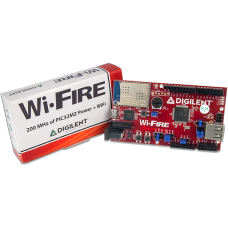Wi-FIRE: WiFi Enabled PIC32MZ Microcontroller Board
Building on the previous successes with the WF32, the Wi-FIRE uses the same 43 available I/O pins, 12 analog inputs, 3.3 operating voltage, 4 user LEDs, potentiometer, buttons, uses MRF24 on-board wireless module, microSD Card, dedicated SPI Signals and high efficiency switching 3.3V switching power supply for low-power operation.
Where the boards differ is in what the PIC32MZ processor can deliver.
The Wi-FIRE is significantly faster than its WF32 counterpart, with 200 MHz operation speed, 2MB of Flash, 512kB RAM, High-Speed USB and a 50MHz SPI. The PIC32MZ core includes the MIPS M5150 CPU Core from OpenOCD.
The Wi-FIRE can be programmed using MPIDE and with the addition of a compatible in-system programmer/debugger, can be used with the more fully featured/advanced Microchip MPLAB® X IDE.
Stats:
Processor/IC: Microchip® PIC32MZ2048EFG100 microcontroller
Connector(s): USB A micro-B cable (USB cable not included), USB Serial Converter, microSD card connector
Programming: MPIDE, MPLAB X (with separate programmer), OpenOCD for hardware debugging
Features:
-
PIC32MZ processor
-
2MB Flash memory
-
512KB RAM
-
200 MHz maximum operating speed
-
50 MHz six 4-wire SPI, six UART modules, five I2C modules, PPS
-
10-bit ADC module: 500 Ksps rate with one Sample and Hold (S&H) circuits, up to 40 analog inputs
-
43 available I/O pins with on-board user interfaces
-
3.3V operating voltage
-
3.3V and 5V regulators
-
12 analog inputs
-
PC connection uses a USB A to micro-B cable (not included)
-
USB 2.0 Full-Speed / Hi-Speed OTG controller with A and micro-AB connectors
-
MicroSD card connector
-
Four LEDs, two Pushbuttons, one Potentiometer
-
Fully supported by MPIDE
-
For more advanced users, MPLAB X IDE is available with a separate programmer
-
EJTAG header for external debugging
-
Microchip MRF24WG0MA WiFi module
-
DSP-enhanced core: Four 64-bit accumulators, single-cycle MAC, saturating and fractional math
For user documentation, software, and tools support for OpenOCD.
What's Included:
- Wi-FIRE
- Custom Digilent cardboard box with protective foam
Support Materials:
For all other material:
Enter the code in the box below:






